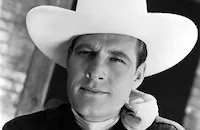Call It Luck
Cast & Crew
James Tinling
"pat" Paterson
Herbert Mundin
Charles Starrett
Gordon Westcott
Georgia Caine
Film Details
Technical Specs

Synopsis
London cabman Herbert Biggelwade, who has won the Derby Sweepstakes, plans to start a foundation to provide homes for cabbies and their horses who have lost their jobs through the advent of taxicabs. First, though, he arranges to visit America with his niece, Pat Laurie, a music hall performer. Before leaving London, Biggelwade is duped into buying an old cavalry horse, which he thinks is Sabre, the blood brother of the Derby winner Scimitar. As they arrive with the horse in New York, Biggelwade is separated from Pat. Conmen "Lucky" Luke Bartlett and Nat Underwood, impersonating the mayor and a senator, present Biggelwade with the key to the city and convince him that an ongoing parade for a flyer is, in fact, for him. While looking for her uncle, Pat meets Stan Russell, a down-on-his-luck Harvard graduate who is now a driver for hire, and he offers to help. Meanwhile, Luke, Nat and their colleagues involve Biggelwade in an elaborate ruse, which results in him parting with the rest of the sweepstakes money to save himself from the electric chair. When Pat and Stan locate him, Biggelwade tells them that he was robbed. Stan takes them to live at the boardinghouse run by his friend, Mrs. Amy Lark, who does not want to take their money. Pat decides to get a job singing in a nightclub to pay Amy and insists that her uncle sell Sabre, whom Biggelwade plans to enter in the upcoming Gordon Handicap. Amy then buys a hansom cab for Sabre to pull and for Biggelwade, who thinks it beneath Sabre's dignity, to drive. In the park, Biggelwade sees his old commanding officer with a troop of boys. When Biggelwade demonstrates his old cavalry call to charge on the bugle, Sabre, with Amy hanging on, runs wildly until Biggelwade gets control of the cab and comforts Amy. Praising Biggelwade's courage, Amy insists on using the $25,000 insurance money that she collected after her late husband's death to bet on Sabre, whom they figure will be a long shot. After Biggelwade meets Luke and Nat again and, feeling indebted to them, tells them to bet on Sabre and mentions the $25,000, they see that the horse is no winner and send a colleague to take Biggelwade's bet with five-to-one odds. Pat learns about the bet and, after seeing Lord Poindexter, the owner of Scimitar, at the club where she sings, Pat learns from him that the real Sabre has just arrived in the States. They then switch horses and lock Biggelwade and his horse in a barn near the track. Luke and Nat, aware of the switch, then conduct a switch of their own and hide the real Sabre. When he inadvertently blows a car horn, Biggelwade discovers that the horse kicks violently. He keeping blowing the horn until the horse kicks through a wall and then rides the horse to the track just in time for the start of the race. When the horse lags behind, Biggelwade takes a trumpet from a band member and blows his cavalry charge through the announcer's microphone. The horse wins, and later in London, Biggelwade, with Amy, opens the Amy Biggelwade Foundation for Homeless Cabmen.

Director
James Tinling
Cast
"pat" Paterson

Herbert Mundin

Charles Starrett
Gordon Westcott
Georgia Caine
Theodor Von Eltz
Reginald Mason
Ernest Wood
Ray Mayer

Susan Fleming
Harrison Greene
Ethel Griffies
Jameson Thomas
Paul Stanton
Sherry Hall
George Magrill
Jack Stoney
Gloria Roy
Patrick J. Moriarity
Eddie Arden
Harry Watson

Fred Malatesta
Fredrik Vogeding
Arthur Vinton
Charles Hall
Spencer Ball
Raymond Turner
Charles R. Moore
Tom Mcguire
Landers Stevens
Maybelle Palmer
Heinie Conklin
Harry C. Bradley
Clyde Dilson
Lawrence Harris
Thomas Abernathy
Sam Ash
Cyril Ring
Matt Mchugh
Crew
Gordon Carveth
Sidney Clare
Duncan Cramer
Warner Cruze
Joseph Cunningham
Harry Dawe
Percy Ikerd
Samuel Kaylin
Sammy Lee
Fred Leigh
Cliff Lyons
Del Maggert
Helen Marlowe
George Marshall
Harry Mccoy
Frank Mcgrath
Dudley Nichols
Dudley Nichols
Frank Powolny
Albert W. Protzman
Royer
Winfield R. Sheehan
Johnny W. Sinclair
John Stone
Alex Troffey
Lamar Trotti
Joseph Valentine
Richard Whiting

Film Details
Technical Specs

Quotes
Trivia
Notes
The original manuscript by Dudley Nichols and George Marshall was entitled "Horse Race Story." Motion Picture Herald noted the "present hysteria that is selling millions of Irish sweepstakes tickets." Variety commented that "Herbert Mundin steals the picture despite that Pat Paterson, whom Fox is trying to build up, is given every opportunity to snatch attention." While a Daily Variety news item, dated March 26, 1934, stated that the race sequences were to be shot at the county fairgrounds in Compton, CA on 27 Mar, a news item dated April 2, 1934, also in Daily Variety, stated that these sequences were shot in Pomona, CA.












